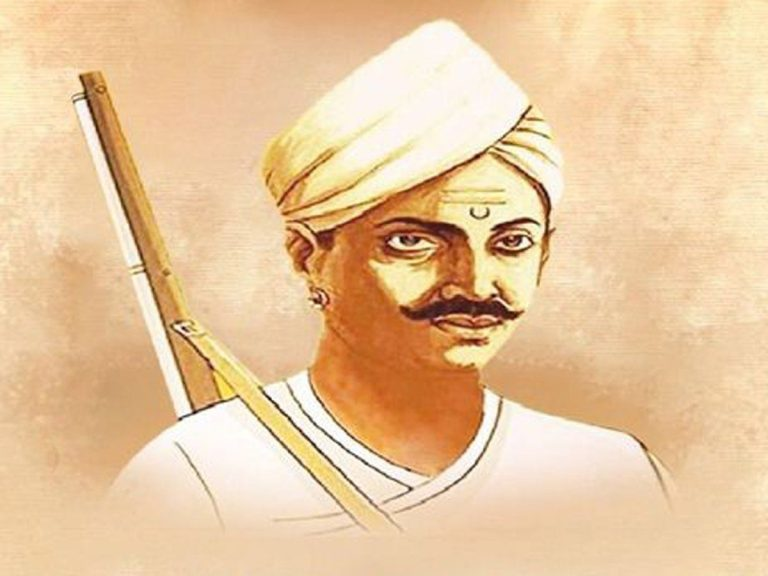Uttar Pradesh
Birth Anniversary of Mangal Pandey
- 21 Jul 2025
- 6 min read
Why in News?
The Prime Minister paid tribute to the great freedom fighter Mangal Pandey on his 198th birth anniversary on 19th July 2025.
Key Points
About Mangal Pandey
- Early Life and Background:
- Born on July 19, 1827, in Nagwa village of Ballia district (present-day Uttar Pradesh), Mangal Pandey hailed from a Bhumihar Brahmin family.
- He joined the East India Company’s army at age 22, serving in the 6th Company of the 34th Bengal Native Infantry.
- Role in Revolt of 1857:
- He refused to use the newly introduced Enfield Pattern 1853 rifle-musket, as it was believed that its cartridges were greased with beef and pork fat. It offended both Hindu and Muslim sepoys, who had to bite them open to load the weapon.
- On 29 March 1857, he fired the first shot of rebellion at the Sergeant Major of his regiment in Barrackpore, near Kolkata.
- This act of defiance triggered the historic Revolt of 1857, often referred to as the Sepoy Mutiny or the First War of Indian Independence.
- The uprising ultimately led to the end of the East India Company's rule in India, with the British Crown taking direct control through Queen Victoria’s Proclamation of 1858 and the enactment of the Government of India Act, 1858, which appointed a Viceroy in place of the Governor-General.
- Lord Canning became the first Viceroy under this new system.
- He was subsequently overpowered and hanged on 8 April 1857, by order of a Court Martial at Lal Bagan, Barrackpore.
- After Pandey’s execution, the 7th Awadh Regiment revolted and faced suppression. His regiment was disbanded, similar to the 19th Infantry at Behrampore, for displaying dissent.
- The rebellion spread across army cantonments—in Ambala, Lucknow, and Meerut.
- On 10 May 1857, sepoys in Meerut launched the uprising that escalated into a nationwide revolt.
- They marched to Delhi, urging the aged Bahadur Shah II to become their symbolic emperor. After persuasion, he accepted and was declared Shah-en-shah-i-Hindustan.
- He was the last Mughal emperor, exiled to Rangoon after the failure of the revolt.
- The Red Fort was seized on 19 September 1857, and he remained in captivity until he died in 1862.
- Significance: Mangal Pandey’s defiance in Barrackpore was not an isolated incident but a culmination of widespread resentment, religious grievances, and economic exploitation under British rule. His legacy as the trigger of the First War of Indian Independence continues to be remembered as a symbol of national resistance and patriotic sacrifice.
About Socio-Political Context of Awadh
- Mangal Pandey belonged to Awadh, a key region for Company recruitment. 75,000 sepoys from Awadh were part of the British army, and almost every agricultural family had a representative serving.
- The annexation of Awadh in 1856 by Lord Dalhousie on the grounds of misgovernance (not under the Doctrine of Lapse) and the land revenue settlements caused deep resentment.
- The Doctrine of Lapse was introduced by Lord Dalhousie (Governor-General, 1848–56). It denied adopted heirs the right to inherit kingdoms, leading to the annexation of states like Satara (1848), Punjab (1849), Jhansi, and Nagpur (1854).
- Confiscation of taluqdars' lands and harsh revenue systems led to 14,000 petitions from sepoys protesting their economic hardships. Pandey’s rebellion thus became symbolic of this cumulative peasant-military discontent.
About Other Prominent Leaders of the 1857 Revolt
- Nana Sahib (Kanpur): Adopted son of Peshwa Baji Rao II; denied pension rights by the British. Took leadership in Kanpur; fled to Nepal in 1859, where he likely died.
- Begum Hazrat Mahal (Lucknow): Widow of Nawab Wajid Ali Shah; led the revolt from Lucknow. Crowned her son Birjis Qadr as king. Lived in exile in Nepal until her death in 1879.
- Veer Kuwar Singh (Bihar): 80-year-old zamindar from Bhojpur; led guerrilla warfare. Retook Jagdishpur in 1858 before succumbing to injuries.
- Rani Laxmibai (Jhansi): Denied succession under the Doctrine of Lapse. Fought British forces under General Hugh Rose in 1858.
- Khan Bahadur Khan (Bareilly): Led a prolonged resistance in Bareilly at age 82; fought Sir Colin Campbell.
- Maulvi Liaqat Ali (Allahabad): Controlled Allahabad briefly; operated from Khusro Bagh. Arrested in 1872 and deported to Andaman Islands.







